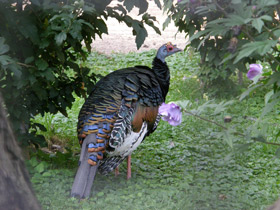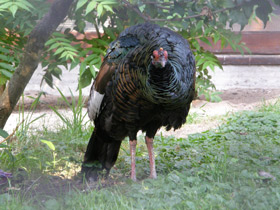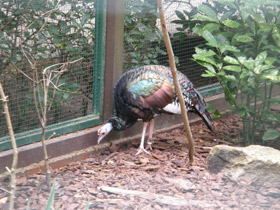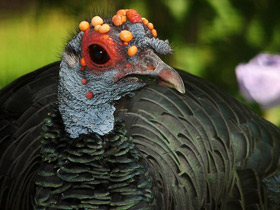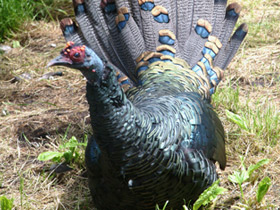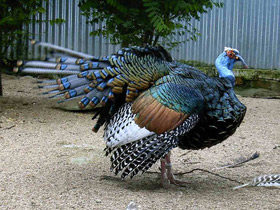The ocellated turkey Agriocharis ocellata
The ocellated turkey is certainly the most beautiful of all turkeys. The body feathers of the ocellated turkey are a mixture of bronze, green and blue iridescent colours, with golden-green fringes, and the splendid bluish-grey tail and upper tail coverts have bright blue-green eye-shaped spots (occelli) bordered with black. However, ocellated turkeys have rather ugly bright blue heads covered with orange and red lumps (“warts”).
Similar to other representatives of their genus, ocellated turkeys are excellent runners who are able to swiftly escape predators. This feature justifies this bird’s Latin name, which comes from a Greek myth about the wing-footed hero Meleager. Ocellated turkeys can easily run at a speed of 30 km/h, and in exceptional cases are able to run at 50 km/h. It should be noted that turkeys are quite tough and can maintain high speed for a long time, which they cannot do, when they fly. A turkey may sharply change direction during the run and, in historical times, it was not easy even for the equestrians to catch these birds. Turkeys can fly swiftly and powerfully for short distances and use these skills for flying up onto a tall roosting tree.
The ocellated turkey’s range extends over 130,000 sq. km in Central America and includes southeast Mexico (Yucatan peninsula), north Guatemala, and north-west Belize. These birds are sedentary. They live in flocks of 5–20 individuals. Ocellated turkeys are most active during the day; they forage in the down or in the dusk and roost in trees at night. Ocellated turkeys feed on plant material, giving preference to dry fruit rich in calories, such as nuts, acorns, pine seeds, and juniper berries. Besides, their diet includes small grass seeds, lush berries of small shrubs, bulbs, diverse insects, small toads, frogs, lizards, and snakes. Adult turkeys consume plenty of lush grass.
Courtship display of the male starts with gobbling and strutting. During the strut, the male spreads the tail fan, holds his head and neck back over the body, drags both wings on the ground, and vibrates one wing. Display of the ocellated turkey male is thought to be as impressive as the display of the peacock. Female turkeys make a nest in the shallow depression in the ground, lining it with dry grass and leaves. The average clutch size is 12 eggs; the female alone incubates the eggs for 28 days. Hatching takes 12 to 18 hours. The chicks are able to follow the female shortly after hatching. Female turkeys provide their chicks with great care. They take their offspring to the sites with abundant food and fervently watch the surroundings, trying to protect their young. During the first two weeks, chicks stay on the ground in the night, and after they fledge, their mother encourages them to fly on the lower branches of a roosting tree.
The first attempt to bring ocellated turkeys to Europe was a failure: the crate with outlandish birds drowned in the River Thames in 1920, in the course of the transportation of the ocellated turkeys to London. Today, world zoo population of the ocellated turkey is almost as numerous as the wild population of this species, which may help saving these beautiful birds for further generations.

















